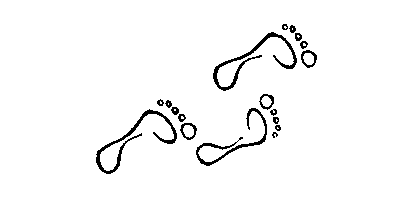The traditional Polish dinner is invariably associated with potatoes. For breakfast we most eagerly reach for bread or buns (mostly white). Meanwhile, we have a lot of healthy replacements of the common bread. One of them is rice, which you can read about in the article RICE – CALORIES, VARIETES, NUTRITIONAL VALUES
Today I propose another, much healthier substitute, namely all kinds of groats, which were actually a basis of Polish cuisine hundreds of years ago – before the formation of the Poland as a country. At some point, however, they began to be associated with the food of the poor, and have been for a long time forgotten. It is only now that it is slowly winning our favor again because of its high nutritional values and slowly released energy, as well as countless possibilities of use in the kitchen.
Groats is the edible cereal (and pseudocereal) seeds. They are peeled and polished (or cut) and then cleaned, degreased and exposed to heat treatment. Thanks to a high content of starch it has a high nutritional value. Groats are rich in complex carbohydrates and protein.
WHY GROATS
Groat is increasingly appreciated as the foundation of a healthy, balanced diet. We should resort to it as often as possible because:
- It is a whole grain product. This means that the grain is not husked, and therefore the most valuable elements in terms of nutritional values remain intact.
- It is a rich source of fiber, which regulates digestion, prevents constipation and bowel cancer. Fiber is also responsible for the low glycemic index of groats – it causes a slower release of energy from carbohydrates and longer lasting satiety. The high fiber content also lowers the bad cholesterol level in the blood.
- It delivers many minerals and vitamins. Groats is a rich source of magnesium, iron, zinc, potassium and B-group vitamins. As a result, it has beneficial effects on our concentration, prevents irritation and insomnia, positively affects the condition of hair, skin and nails.
- It contains a lot of protein (nearly 10%). It has a lower nutritional value than meat and dairy protein and therefore is often combined with meat, milk or cream.
- It comes in many varieties and is easy to prepare – large diversity of groats means that everyone is able to find the kind that will suit them. Preparation of groats takes 15-20 minutes and its storage does not require any special storage conditions.
NUTRITIONAL VALUES

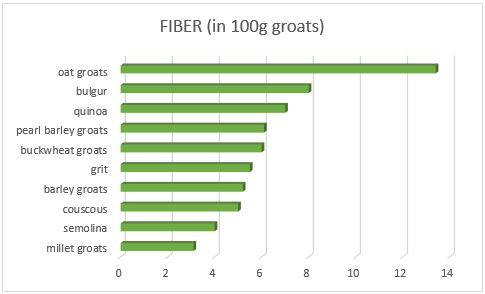

VARIETIES
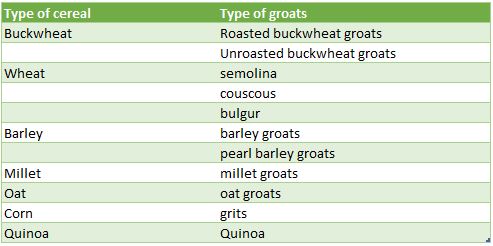
BUCKWHEAT GROATS
DESCRIPTION:
- Unroasted – it has a light color and softer and less distinctive flavour than roasted variety. It is cooked longer
- Roasted – it has walnut colour and intense, distinctive flavor. It is more popular than unroasted.
NUTRITIONAL VALUES:
- Buckwheat contains a lot of protein, calcium, iron, phosphorus, potassium and magnesium.
- It is rich in antioxidants, thus it strengthens blood vessels and prevents the development of varicose veins and breaking blood vessels. It has anticoagulant properties, slows the aging processes and strengthens the immune system.
- It has a high fiber content and low glycemic index. It also includes D-chiro-inositol, which affects the proper functioning of insulin, and therefore is recommended for people with diabetes.
- It is gluten-free, so it can be part of the diet of people with celiac disease.
POSSIBLE USE:
COOKING INSTRUCTIONS: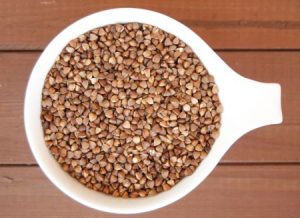
- Boil water with oil and a pinch of salt.
- Toss buckwheat groats into boiling water (1 cup groats per 1,5-2 glasses of water).
- Cook until groats absorbs almost all of the water (approx. 15 minutes).
- Remove the pan from the heat, cover tightly and leave to absorb the rest of the fluid (approx. 10 minutes).
MILLET
DESCRIPTION:
Millet is very quickly winning our favor thanks to the richness of nutritional values. It is produced of hulled millet grain. Appears mostly in the yellow color, but there are also white, gray and red millet. It is gluten-free and the only one with deacidification properties. There is a boundless number of ideas how to use millet throughout the internet.
NUTRITIONAL VALUES:
- Of all the groats millet has the highest content of iron, copper, vitamin B1, B2 and B6.
- It is a source of silicon – it has a positive effect on bones and joints, maintains the walls of blood vessels in good shape, strengthens the immune system and reduces inflammation.
- It provides lecithin, which is responsible for the proper functioning of the nervous system. Millet also reduces bad cholesterol levels.
- It has anti-viral properties, therapeutic effects on joints and skin, hair and nails.
- As for the zinc content it nearly equals buckwheat.
- It has deacidification properties
- millet is gluten-free
POSSIBLE USE:
Used both in sweet and dry dishes. You can serve it to dinner instead of potatoes as well as a salad ingredient. Cooked soft, it provides an excellent base for veggie burgers, pies or casseroles. It can be used for a variety of sandwich pastes.
Similarly good when served sweet – as millet oatmeal with nuts or fruit, pudding, but also as a base for gluten-free cakes, pancakes or muffins.
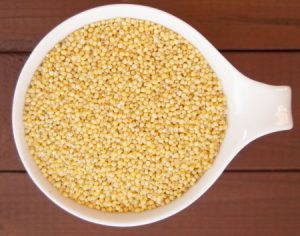 COOKING INSTRUCTIONS:
COOKING INSTRUCTIONS:
- Pour boiling water over millet in a sieve and drain well.
- Boil water with oil and a pinch of salt. Add millet to boiling water and stir for a few minutes to prevent it from sticking (1 cup porridge 1,5-2 glasses of water).
- Cook uncovered approx. 5 minutes while stirring occasionaly. Cover when there is little fluid and heat approx. 5 minutes on low heat.
- Remove from heat, cover tightly and leave for approx. 10 minutes.
BARLEY GROATS
DESCRIPTION:
Barley graots is produced from barley. In Poland it is the most popular variety, produced in greatest quantities. There are three types of barley:
- whole wheat barley groats – it is a whole grain groats, only purified and hulled. It is the least processed groats, thus it preserves the most of the valuable micro- and macro-elements and other nutrients
- broken barley groats – is a fragmented barley groats, except that it is not polished, therefore retaining a significant portion of nutrients. Because of the fragmentation we distinguish coarse, medium and fine groats.
- pearl barley groats – fragmented barley, which is further hulled and polished – this way we receive the groats in a nice shape of pearls, unfortunately deprived of the most valuable elements, as a result of grain processing. Also present as coarse, medium and fine groats.
NUTRITIONAL VALUES:
- a source of β-glucan (soluble fiber), thereby reducing bad cholesterol levels. It positively affects glucose metabolism, protecting against sudden surges in blood sugar. It has beneficial effects on the intestinal mucous membrane.
- It is rich in phytochemicals (lowering cholesterol levels) and antioxidants (ferulic acid, catechins and proanthocyanidins). They have anti-cancer, antibacterial, antiviral and anti-inflammatory properties.
- Barley contains gluten
POSSIBLE USE:
- It is added primarily to barley gruel (hence the name), but would also work in other thick soups and creams
- It is a traditional addition to meats, stews and sauces
- Works well with addition of meat or vegetables as a filling for stuffed cabbage or vegetables (eg. Peppers, tomatoes, zucchini)
- it can be used to make pies and Groat-sotto (italian risotto with barley instead of rice)
- great as a salad ingredient
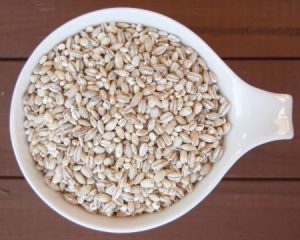 COOKING INSTRUCTIONS:
COOKING INSTRUCTIONS:
- pour warm water over barley groats in a sieve and drain well.
Boil water with oil and a pinch of salt. Add groats to boiling water and stir. (1 cup of groats for 3.5 cups of water)
Cook for approx. 15 minutes on low heat.
When the gorats is soft, drain.
SEMOLINA
DESCRIPTION:
It is a white, fine groats created while milling wheat into flour. It has a high glycemic index, but it is easy to digest. Apart from the usual semolina, in stores you will also find instant semolina (exposed to heat treatment during production, so requires shorter cooking) wholemeal semolina, which is darker and contains more fiber and nutrients.
NUTRITIONAL VALUES:
- it is easy to digest, so often prepared for children and people with gastrointestinal disease or after surgery.
- It has slightly obstructing effect and can alleviate diarrhea
- contains gluten
POSSIBLE USE:
- cooked in milk with fresh or dried fruit or nuts
- in the form of a pudding (eg. with addition of cocoa), as a filling for cakes and pies
- as an addition to soups or base for noodles, burgers and sauces instead of flour
- base of stuffing for stuffed vegetables (eg. peppers, zucchini)
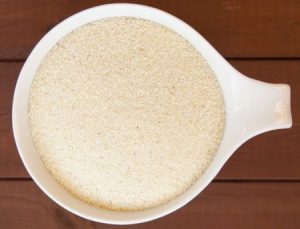 COOKING INSTRUCTIONS:
COOKING INSTRUCTIONS:
- add semolina to cold water or milk (1 cup of semolina for 4 glasses of water or milk)
- Boil water or milk with semolina, stirring constantly.
- Constantly stirring, cook until the liquid is fully absorbed.
CORNMEAL
DESCRIPTION:
Cornmeal is obtained from hulled and crushed grains of corn (maize). It is yellow and fine. Popular all around the world. It is further processed into flour, bread, pies and cakes, bourbon, beer, cereals, crisps or oil. In Poland it is a component of corn porridge for babies, in Italian cuisine popular as polenta, in Romania as mamałyga, and in the countries of South America – tortilla pancakes.
NUTRITIONAL VALUES:
- Like other groats, contains fiber
- is a source of vitamins B1, PP and E
- provides lutein, so it is recommended for people suffering from cataracts and macular degeneration (neutralizes free radicals – the main cause of deterioration of sight)
- cornmeal protein does not contain tryptophan, thus it does not cause allergic reactions.
- is gluten-free
POSSIBLE USE:
- used as a thickener for soups and sauces
- base of stuffings for stuffed vegetables (eg. peppers, zucchini)
- it can be made into gluten-free cakes, bread, noodles and burgers
- as polenta
- ingredient of dry casseroles, goes well with onion and cheese
- as a dessert, cooked in fruit juice with addition of fresh fruit
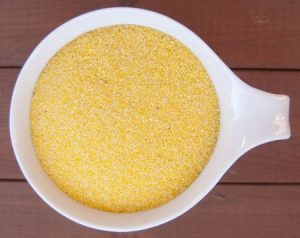 COOKING INSTRUCTIONS:
COOKING INSTRUCTIONS:
- add cornmeal to cold water, juice or mil (1 glass cornmeal for 2,5 glasses fluid)
- cook approx. 15-20 minutes, stirring constantly.
Tip: If you want to receive hard polenta for further processing, put cooked cornmeal on a flat surface (the thickness of the finger), align and leave to cool. Ideally put in the fridge for a few hours. In baking, cornmeal be used as a substitute for eggs. Just mix a spoonful of cornmeal in 2 tablespoons of water and add to cake or pancakes.
COUSCOUS
DESCRIPTION:
It is a product that combines the characteristics of groats and pasta, because it has the appearance of groats, but is produced or wheat granules (semolina) and water. It comes from the north-west Africa. Couscous should be loose.
NUTRITIONAL VALUES:
- it is easy to digest, so it can be consumed by people with stomach and duodenal ulcers, liver disease and bile ducts
- from all the groats couscous contains most protein
- It contains a lot of protein, carbohydrates and very little fiber, which makes it a good meal for athletes
POSSIBLE USE:
- the fastest in the preparation – just pour boiling water over
- tastes good both sweet and savory
- ingredient of many of salads
- base of stuffings for stuffed vegetables (eg. peppers, zucchini)
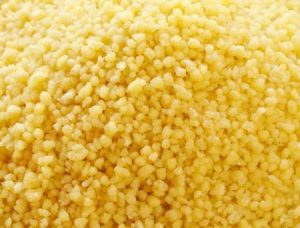 COOKING INSTRUCTIONS:
COOKING INSTRUCTIONS:
- Pour hot water or broth over couscous (1 glass of couscous for a little over 1 glass of fluid)
- Stir and let stand covered for approx. 5 minutes
BULGUR
DESCRIPTION:
Bulgur is produced, like couscous, from wheat grains, it is however a typical groats. Commonly used in Turkish and Middle East cuisine. It comes in three varieties: fine-grained and coarse-grained and medium-grained.
NUTRITIONAL VALUES:
- It contains potassium, calcium, magnesium and sodium – lowers blood pressure, and increases heart contractions during effort, oxygenating whole organism better. It regulates muscle tone and affects the conduction of stimuli in nerve cells
- a source of iron and folic acid to prevent anemia, and thus helps in the treatment of anemia
- contains B vitamins, that improve memory (B1), soothe headaches and dizziness (B2), facilitate the absorption of magnesium (B6), affecting the production of neurotransmitters (serotonin, dopamine and norepinephrine) – reveal an anti-depressant properties
- provides fiber, lowering levels of bad cholesterol in the blood
POSSIBLE USE:
- does well in the same uses as couscous
- due to bigger grains it absorbs more flavours, so it has more pronounced taste than couscous
 COOKING INSTRUCTIONS:
COOKING INSTRUCTIONS:
-
- Pour hot water or broth over bulgur (1 glass of bulgur for 2 glasses of fluid)
- Stir and let stand covered for approx. 15-20 minutes
QUINOA
DESCRIPTION:
Quinoa is a pseudocereal and a distant relative of spinach. It was a basic food of the Incas, replacing corn. They called it „mother of cereals”. It is classified as a „superfood”, i.e. food extremely rich in nutrients. Included by NASA to the diet of astronauts.
NUTRITIONAL VALUES:
- rich in valuable protein, containing all the essential exogenous amino acids (not synthesized by the human body). Particularly important is a high content of lysine, an amino acid important for tissue growth and regeneration
- a source of manganese, magnesium, calcium, iron, copper and phosphorus – is particularly recommended for people with migraine headaches, diabetes and atherosclerosis
- contains more fat than the cereal grains, but mainly consisting of valuable unsaturated fatty acids (such as omega-3).
- is gluten-free
POSSIBLE USE:
- ingredient of many salads
- served to dinner instead of potatoes or rice
- roasted grains taste well with joghurt
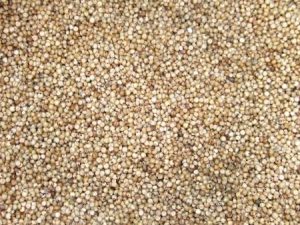 COOKING INSTRUCTIONS:
COOKING INSTRUCTIONS:
- rinse quinoa well under running water
- boil water with oil and a pinch of salt. Add qunoa to boiling water (1 glass quinoa for 2 glasses of water)
- Cook for approx. 15 minutes
